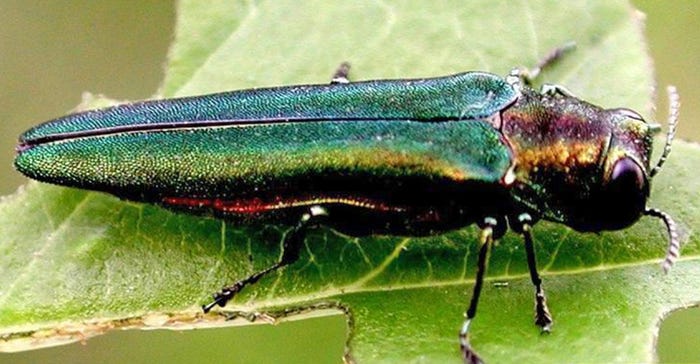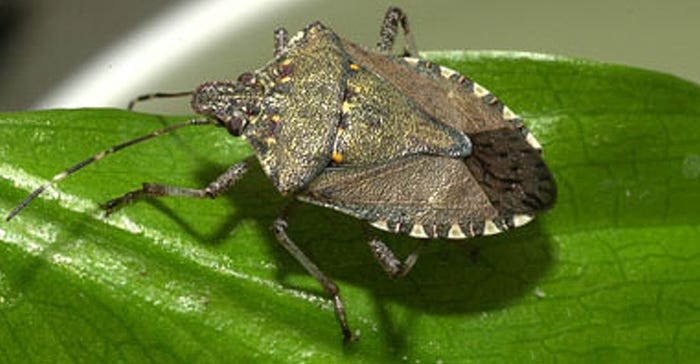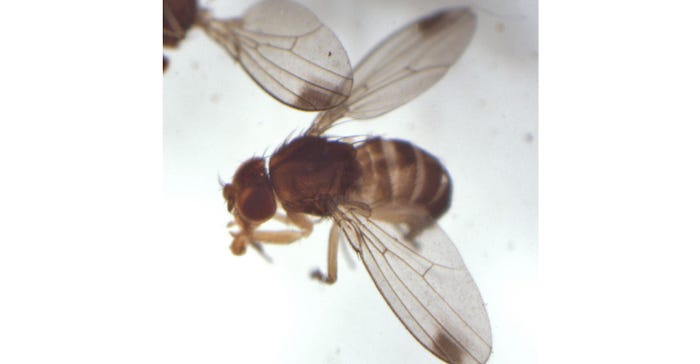April 6, 2017

If you see any of these insects on your farm this year, contact your local county Extension office or the North Dakota Department of Agriculture. The insects are new invasive species that could cause some serious damage to field crops, trees or fruits.
The Japanese beetle is native to Japan and was discovered in the eastern U.S. in 1916. Since then, it has slowly spread west. Japanese beetle has been found in low numbers in North Dakota each year since 2012. The large ½-inch metallic-green beetle with bronze wing coverings attacks a broad range of host materials including turf grasses (larva), field crops (corn and soybeans) and more than 300 species of ornamentals. Japanese beetles have been found in 12 counties in North Dakota. Burleigh, Grand Forks and Cass counties apparently have small, established populations.
 TREE KILLER: The emerald ash borer infests ash trees. (Photo by Leah Bauer, USDA Forest Service Northern Research Station, Bugwood.org)
TREE KILLER: The emerald ash borer infests ash trees. (Photo by Leah Bauer, USDA Forest Service Northern Research Station, Bugwood.org)

Emerald ash borer is an invasive pest from Asia that feeds on ash trees. Likely introduced in wood packing material in the late 1990s, the beetle has been found in 27 states, including 12 counties in Minnesota. Emerald ash borer has killed tens of millions of ash trees across the country. It is spread through the movement of infested nursery stock and firewood. Adult beetles are ½-inch long and have a metallic-green body. The larva damages the conductive tissue under the tree bark, restricting the tree’s ability to move nutrients. Emerald ash borer has not yet been found in North Dakota.
 NEARBY NOW: The brown marmorated stinkbug has been found in Minnesota and Iowa. (Photo by David R. Lance, USDA APHIS PPQ, Bugwood.org)
NEARBY NOW: The brown marmorated stinkbug has been found in Minnesota and Iowa. (Photo by David R. Lance, USDA APHIS PPQ, Bugwood.org)

Brown marmorated stinkbug is a large stinkbug (three-fourths-inch long by three-eighths-inch wide) and could become a pest of soybean, dry bean and field corn. Adults and nymphs damage developing seeds by injecting a toxin into the seed, resulting in deformed seeds. In the fall, these stinkbugs try to get into homes, just like the boxelder bug. Identification is based on a white band on the antennae and alternating black-and-white bands on edge of abdomen. It has not been found in North Dakota yet, but it is in eastern Minnesota and Iowa.
 IN STATE: The spotted-wing drosophila has been discovered in North Dakota. (Photo by Hannah Burrack, North Carolina State University, Bugwood.org)
IN STATE: The spotted-wing drosophila has been discovered in North Dakota. (Photo by Hannah Burrack, North Carolina State University, Bugwood.org)

Spotted-wing drosophila is an invasive insect pest of small fruit crops. It is believed to have originated from Asia. First discovered in North Dakota on tart cherry in 2013, spotted-wing drosophila has spread quickly into 17 counties. Female flies attack fresh and ripening fruits rather than the rotting fruits that similar vinegar flies prefer. It has been confirmed infesting a number of fruit crops in North Dakota, including blackberry, juneberry, raspberry, tart cherry and grape.
Sources: Charles Elhard, plant industries division, North Dakota Department of Agriculture, and Janet J. Knodel, North Dakota State University Extension entomologist
You May Also Like




